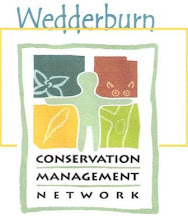
Do malleefowl prefer a position with an open view to the south, or a nice shrubby backyard to the east? Is there a reason why one particular mound is used more often than another mound? Is vegetation structure and quality a limiting factor to where malleefowl will live? These are some of the questions we are trying to answer with our current vegetation surveys.
In 2007 surveys were done at 5 malleefowl mounds in the Wychitella NCR- 2 in the Skinners Flat block, 2 in the Wychitella block and 1 in the Wedderburn block as well as one mound on private property. The mounds range from being currently active, active within the last 5-10 years and long inactive. The method of the surveys is in two parts. The first survey is based on vegetation structure whereby a 50m tape is laid out and at every 50cm a 2m pole is placed and all vegetation touching that pole is recorded including the ground layer and the canopy above. This method gives an indication of the make up of the ground cover, understorey and canopy around the mound. This is then repeated at all four compass points.
The second method is where along the 50m line two 10m square blocks are measured up at the 20-30m point and the 40-50m point. One 1m square block is also set up within these two 10m square blocks. In both the 10m and 1m squared blocks every species is recorded and the number of each of the species is counted.
By comparing the results of the current surveys with the 2007 results it is hoped that we can get a better picture of why malleefowl choose to use one mound over another. It may be the structure of the surrounding vegetation providing better protection or it may be the mixture of species meaning a better supply of quality food, i.e. fungi, berries and insects.
The mound on private property has been completed and the remaining mound surveys will be occurring in the coming weeks. These will be followed by vegetation surveys in the kangaroo exclosure plots and 50m structure surveys in the Wychitella NCR. If you are interested in helping please let me know. Knowledge of plant species is not essential, but would be helpful, but there are some difficult working conditions involved.
Article by Wendy Murphy, WCMN Ranger, Photograph - Peter Watts

No comments:
Post a Comment